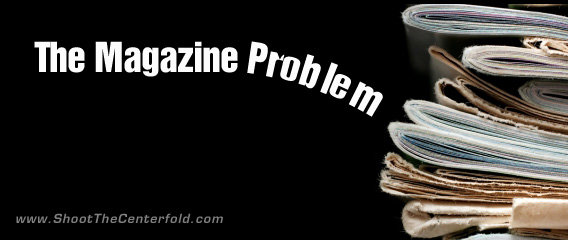Magazines Don’t Have a Digital Problem, They Have a Bundling Problem
 New media and publishing dynamics have changed the economics for magazines to the extent that it is simply not possible to continue with existing models. Much of the issue is that magazine publishers are misidentifying their problems, striving to find new ways to distribute their packages without acknowledging that those very packages are fast becoming relics, a testament to a time past, when publishers had the power of platform and could demand that readers come to them. The latest figures prove that approach is no longer tenable.
New media and publishing dynamics have changed the economics for magazines to the extent that it is simply not possible to continue with existing models. Much of the issue is that magazine publishers are misidentifying their problems, striving to find new ways to distribute their packages without acknowledging that those very packages are fast becoming relics, a testament to a time past, when publishers had the power of platform and could demand that readers come to them. The latest figures prove that approach is no longer tenable.
In the first half of this year, magazine newsstand circulations dropped 10 percent, according to the Audit Bureau of Circulations. “When 10 percent of your retail buyers depart over the course of a year, something fundamental is at work,” wrote David Carr in his New York Times media column yesterday. Just as bad, advertising is down 8.8 percent compared to the same time last year, according to the Publishers Information Bureau.
Lest you think this is just a paper problem, keep a close eye on what’s happening with tablet-only magazines. If publishers thought tablets were going to be the saviors of their industry, they must be really bummed out by recent news that The Daily is cutting a third of its staff and the Huffington Post has decided to stop charging for its iPad magazine after just five issues. Working on the principle that three events equal a trend and two pass for a story, AdWeek last week asked “Are Tablet-Only Publications Dead?”.
It’s far too early to say they’re dead, but there’s good reason to believe that the very idea of “tablet-only” has limited purchase. Magazine content might not want to be free – it costs too much to want to simply give itself away – but it certainly wants to flow freely to wherever the readers are.
Ten years ago, those readers were on the bus, on the couch, in waiting rooms, and on the beach – places where paper could dominate, and where PCs and even laptops couldn’t offer competitive longform reading experiences. Today, tablets and smartphones accomplish what paper owned in those years, but with added benefits – no pages that flutter in the wind, instant access to information from all over the world, supreme portability, and the ability to immediately share content with friends.
On tablets and smartphones, though, the package no longer makes sense. We humans still love to read – and since getting a Kindle, and then an iPhone, and then an iPad, I now read more magazine journalism than ever – but we want to do it on our terms. We will always need editors to commission and shape strong stories, but we don’t need them so much to bundle disparate pieces of content into one immutable chunk. Instead, many of the most savvy readers prefer to consume magazine journalism piece by piece, taking note of the source from which it sprung, but not necessarily paying heed to whatever else happened to be placed alongside it in that source that particular week or month. Often what is more important is who wrote it, what it’s about, or when it happened to fall into view.
I haven’t got a focus group to prove this, but I would bet that anyone who uses reading apps such as Longform, Instapaper, Readability, and Pocket prefers those content delivery mechanisms to bundled magazines. These platforms allow readers to select and sort content in a way that works for them, from disparate sources, without having to deal with cumbersome digital magazine files and swathes of packaged content that simply isn’t relevant, or of interest.
Defenders of the bundle insist that “discovery” and serendipity are vital aspects of the magazine reading experience. And I agree. But I don’t agree that the package is the best way of delivering on that discovery promise. Twitter, Facebook, Flipboard, and Pulse all do a better job at delivering “discovery,” because, when used well, they expose us to a wider range of tastes and interests than the editorial boards of specific publications. And actually, they also accommodate the tastes and interests of those editorial boards, because magazines like the New Yorker and Newsweek and Vogue and whoever else can take full advantage of those platforms to drive people to their content.
What magazines have to get used to is that they’re now competing against other, leaner and sometimes more digitally savvy, curators and publishers in the content marketplace. Many in the latter group are willing to give their content away for free, and none insists – or relies – on a bundled product that is sold on a newsstand, be it virtual or otherwise.
Set-ups like Longform, Longreads, Brain Pickings, Dave Pell’s NextDraft, and Conor Friedersdorf’s Best of Journaliam take care of interest arousal and curation, all while directing traffic to traditional publishers. These experiences don’t require hefty apps or heavily designed products – most of the time, they point to or present content that is basic text and pictures. They satisfy the need to read and be informed without demanding that readers commit to downloading a heavy package every week or month.
Traditional magazine publishers have to both take advantage of and compete with these services. Ultimately, they will lose the bundling aspect of their model that has in the past sustained their businesses. They will have to adapt to, and capitalize on, a new environment in which their core editing and curation strengths are in demand, but in which they can no longer determine the mode of delivery.
In the future, magazine brands will be producers, endorsers, commissioners, curators, designers, and promoters – but they won’t primarily be bundlers. The bundle may still exist, but it will be a much smaller piece of the magazine business than it is today. The printed product, for instance, might ultimately be a prestige item distributed occasionally as a supplement to, or showcase of, the brand’s best work according to a particular theme or period of time. It’s difficult to envisage a printed product that in 10 years will be profitable when produced on a weekly or monthly basis.
This is bad news for magazines, but it’s not end news. Publishers are now coming to the realization that their current models are unsustainable in the tablet and smartphone era. People are going to lose jobs, magazines are going to close down, and the world will be poorer for quality content.
But the game isn’t over for journalists and editors – it’ll just be leaner and different. They will have to produce content that can move easily outside the borders of pages and apps, content that can be shared – even purchased – at the click of a button, content that can live on the strength of its reporting and writing.
The good news is that journalists and editors today are already producing a ton of content that qualifies according to those parameters. The challenge that remains is how to most effectively deliver it to readers while still extracting a dollar from their product. That may be done with micropayments, or it might be done – as suggested before – via a Netflix-style all-you-can-eat model.
That reality might mean magazine publishers will ultimately preside over businesses that are just a shadow of their former selves. But the other option is likely even less palatable. The period of time in which magazines can get away with losing 10 percent of their newsstand circulation is extremely limited.




















“The World will be poorer for quality content” huh? I don’t think so. I think it will be richer. It already is. There seems to be more content, so the quality content may be less obvious, but I think there already is MORE quality content, making the World richer for quality content right now. The future is only going to get better, when publishers finally embrace what is happening the way they should, and do what they should have done five years ago . . . concentrate on building it, rather than acting like they are afraid of it.
Agree and disagree, I think there is a problem in delivery platform more than anything else. As far content goes … world is over-saturated with less of a quality content. I don’t see that anybody is afraid of anything as Scott suggests. It’s more about wild-west style digital revolution that still has to find its performance path to maximize everything.